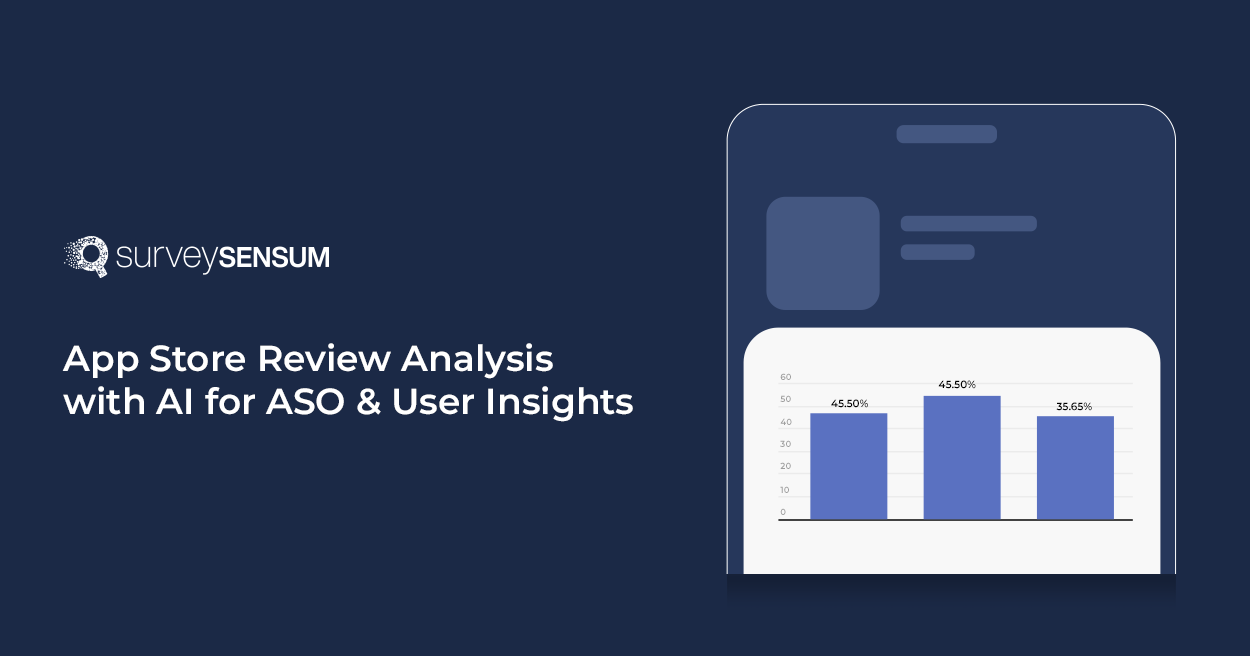

360-degree feedback is tedious and
Did you know that 33% of employees want to receive continuous feedback outside of an annual or traditional review?
If you are not assessing your employees on a regular basis and providing them with constructive criticisms, then you are missing out on the amazing benefits of 360-degree feedback surveys to improve your employee experience and satisfaction.
But wait, what exactly is a 360-degree feedback survey and why should you talk about it?
Picture this: instead of just hearing what your manager thinks, you get insights from your peers, direct reports, and maybe even clients or customers. It’s like having your own personal focus group, giving you a full picture of how you’re doing and where you can grow.
That’s precisely what the 360-degree feedback survey offers – a holistic view of an individual’s performance, behaviors, and competencies from multiple vantage points. It’s like having a panoramic lens to capture a fuller picture of an employee’s contributions and potential.
So, if you’re looking to shake things up and take your employee engagement to the next level, 360-degree feedback surveys are the way to do it. They’re not just about feedback – they’re about building a culture of trust, growth, and excellence. And trust me, once you try them, you’ll wonder how you ever did without them.
But before you jump into it let’s first understand 360 employee feedback in detail, why it matters, its advantages, and how to launch these surveys using a robust employee feedback tool.
So, what is a 360-degree feedback system?
360-degree feedback, also known as a 360 assessment program or 360 reviewer program, is a multi-rater feedback system that gives anonymous feedback to each employee on their overall performance from their peers, managers, and subordinates – that’s why the name ‘360 degree’.
The employee evaluation method called 360-degree feedback may include feedback from everyone around and about everyone so that even managers get to know their strengths and weaknesses and their peers’ opinions towards them. Utilizing an anonymous feedback tool, the 360-degree feedback process ensures confidentiality and fosters open communication among all stakeholders.

But, how does it work?
After everyone shares their feedback, the 360-degree feedback software compiles the results and comprehensively tabulates them into bar graphs or line charts so that everyone can understand them clearly.
So, what does a 360-degree feedback program actually measure?
What Does a 360-Degree Feedback System Measure?
A 360-degree feedback system measures the following things.
- It measures employees’ behavior and competency to work with others.
- It tells you what everyone thinks of everyone and how strong is the culture in the organization.
- It focuses on subjective areas like character, teamwork, and leadership effectiveness.
- It also addresses listening, planning, goal-setting, teamwork, and leadership skills.
Alternatively, what does 360-degree feedback not measure?
Here are a few things that 360-degree feedback does not measure.
- It does not measure the employees’ skill sets.
- It does not tell if an employee is meeting the basic job requirements.
- It doesn’t measure objective things like attendance, sales quotas, etc.
But why use a 360-degree feedback system at all and not a traditional performance review? Let’s see.
How is 360-degree Feedback Different From Traditional Performance Reviews?
- Team A says that you don’t talk to everybody. On the other hand, your manager says that your overall performance has been really good so far.
- However, your manager doesn’t know what the team thinks about you and your performance and gives you a bonus.
- Don’t you think that the manager should consider the feedback from the team before making this decision?
- This is where the 360-degree feedback system kicks in.
- By embracing the 360-degree feedback approach, organizations empower employees to grow and thrive by leveraging insights from all angles, ensuring that bonuses and recognition are not just based on individual achievements but also on the collective feedback from those you work closely with.
The 360-degree feedback system is different from traditional performance reviews because traditional performance reviews take place between a manager and a subordinate. However, in the 360-degree feedback system, everyone in the team/organization is involved.
360-degree feedback gives you overall feedback about employees’ overall performance anonymously from other employees. This diverse feedback can help them identify what is working and what is not so that they can work on it accordingly.
Certainly, how the feedback is conveyed plays a crucial role. It’s important that managers learn about Performance review phrases to effectively reframe the “positive” and “constructive” feedback. Using appropriate words throughout the performance review phrases will ensure that the message is provided and received appropriately.
Now the question is, where does 360-degree feedback help?
Advantages of 360-degree Feedback
Once your organization starts conducting the 360-degree feedback system, the following are the changes you will observe.
1. Increased Self-Awareness Among Employees
A 360-degree feedback system helps employees get to know a lot about themselves from diverse perspectives. This helps them to know themselves much better and can improve on things that they are lacking.
For instance, if an employee receives feedback that they don’t have a good bond with other team members of different departments, then that is something for them to work on and improve.
2. A Culture of Open Communication
According to research in The Deskless Report, 65% of corporate leaders believe their communication is effective, while only 35% of frontline workers agree
This shows a serious disconnect in the organization.
This is where 360-degree feedback helps you generate a flow of open communication at every level, such as from manager to subordinates and vice versa. This feedback offers an equal platform to everyone where they can honestly communicate and put their thoughts on the table – especially for organizations where the team size is huge.
3. No More Discrimination or Partiality
Did you know that 60% of employees report experiencing bias in the workplace?
Who doesn’t want to work in an unbiased workplace? As the feedback comes from multiple employees anonymously, everyone can easily share their honest feedback building a healthy culture in the organization and eliminating any kind of discrimination.
4. Bridges Training Gaps
According to Axonify’s State of Workplace Training research report, 92% of workers think workplace training positively impacts their job engagement.
360-degree feedback helps you to grow personally and professionally. This feedback, when analyzed, helps HR identify the common skills that most employees are lacking. They can then organize training sessions for the employees to boost their skill set, and this helps in employee retention.
Launch your first 360-degree feedback survey with SurveySensum in just 5 minutes!
These are the advantages of 360-degree feedback surveys, but where do they lack?
Disadvantages of 360-degree Feedback
360-degree feedback comes with its limitations. Let’s have a look at it.
1. Inexperienced Respondents Leading to Useless Feedback
The people new to this survey may not understand or answer all the questions clearly. They need to be trained on how to answer these questions constructively and not be biased towards one person.
2. Lack of Communication Gap
The best thing about 360-degree customer feedback is that it is anonymous. However, it can be an issue if an X employee (who has received negative feedback) wants to clarify their feedback with someone. That’s why it is advisable to take the feedback in a supporting spirit, improve what you can, and not worry about the rest.
3. Not-so-Reliable Data
Many employees in some organizations game the system. They collaborate and plan to give positive feedback to one another instead of being honest. This way the survey is useless. That’s why communicate the objective of the survey clearly to everyone and ensure that everyone understands the importance of this survey.
4. Focuses on the Negative Feedback
One should not only focus on the negatives. And that goes for the 360-degree feedback as well.
Post analyzing the feedback, some organizations highlight only the negative traits of the employee. Don’t do this. The employees will be discouraged and with time, will lose their trust in the feedback.
5. Not Apt for Small Organizations
360-degree feedback isn’t apt for those organizations where there are few employees or sources.
Let’s summarize the pros and cons of launching 360-degree feedback surveys.
Pros and Cons of 360-degree Feedback – Summary
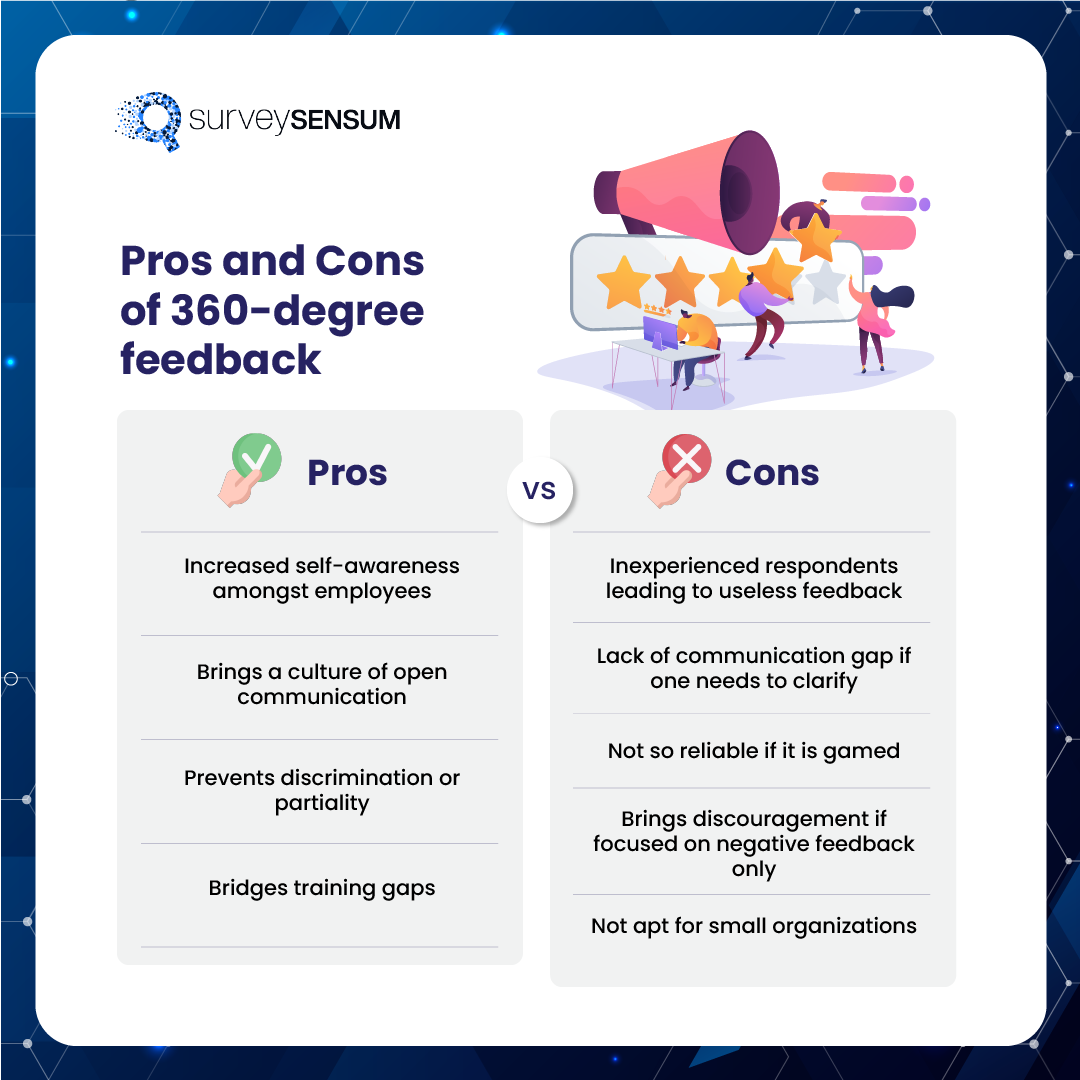
| Pros | Cons |
| Increased self-awareness among employees | Inexperienced respondents lead to irrelevant feedback |
| Establishes a culture of open communication | Lack of communication gap if one needs to communicate |
| Prevents discrimination or partiality | Not-so-reliable if it is gamed |
| Bridges training gaps | Brings discouragement if focused on negative feedback only |
Launch 360-degree feedback surveys to give your employees honest and constructive criticism!
Now, we have covered what 360-degree feedback is, what it measures and what are its pros and cons. But to launch a 360-degree feedback system efficiently, you’d need feedback management software that helps you create and share the survey and gather and analyze the feedback. And there are many other reasons for it.
Let’s discuss some of them!
Why Should You Go for Efficient 360-degree Feedback Software?
The 360-degree feedback software helps you to track the success rate or growth of an employee if done continuously. There are many advantages to it.
1. Comprehensive Results Post Analysis

An efficient 360-degree feedback software will be able to help you consolidate all your feedback, analyze it, and present it in a comprehensive and customizable dashboard with visual effects. You have the option of representing data in various ways such as a bar chart or line graph to show the results of all the feedback with a summary, making it easier to understand. Also, it can deliver individualized reports, team reports, or the entire organization while protecting everyone’s identity.
2. Pre-designed Survey Templates
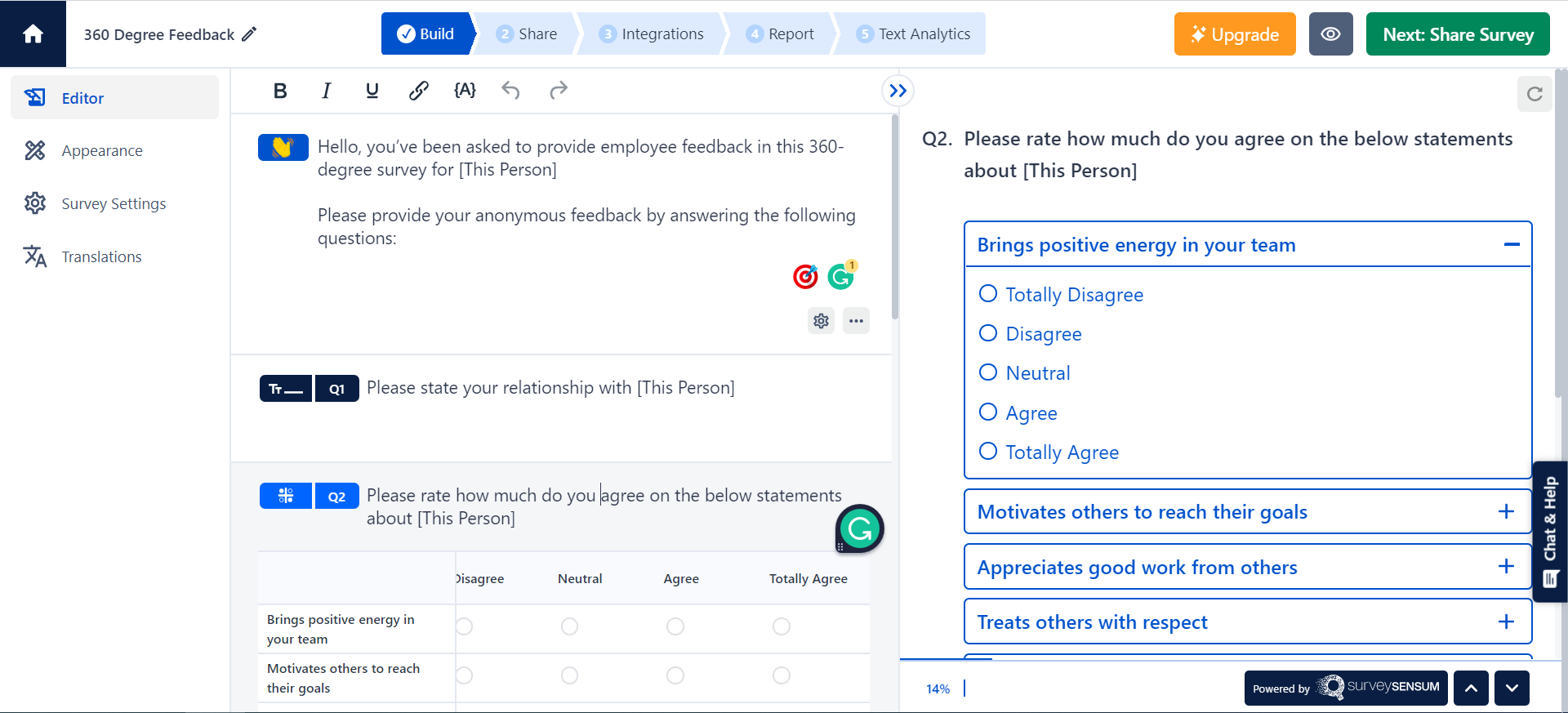
The 360-degree feedback software also offers pre-designed survey templates making it easy for HR to create and share the surveys across the organization. These templates have sample questions that can be customized by the HR as per the objective of the survey. You can also customize the survey settings and themes to match your organization’s identity.
→ Read more on the Top 360-Degree Feedback Systems for Small Organizations.
3. Automation
The entire process of launching 360-degree feedback is tedious and time-consuming. However, the feedback management software makes it easy. It automates multiple processes like sending surveys, setting up reminders, managing a contact list, and more.
But that’s not it! There are a few tips that you should keep in mind for an effective 360-degree feedback system.
4. Analysis and Reporting

With an efficient feedback system, you can manage and analyze feedback with automation which helps you save time and energy with manual analysis. Features like Text Analytics software will help you tag and categorize your feedback into different relevant categories by using the power of machine learning. Next, the software will show you a detailed and consolidated report that will help you see which areas need improvement.
Leverage the power of Text Analytics software to manage and analyze your feedback systematically!
Tips to Launch an Effective 360-degree Feedback Survey
Here are the 8 things that you should keep in mind.
- Don’t forget to create and communicate the objective of the survey.
- Give training to all the employees.
- Involve managers and leaders to know what things are asked from their teams.
- Ask managers or leaders to set behavioral goals for the teams.
- Inform your team/organization about the importance of conducting this feedback.
- Know what questions to ask and how and customize accordingly.
While creating the survey
- Ask open-ended and straightforward questions.
- Try not to make all the questions compulsory, add optional questions as well.
- Make sure that each question instantly communicates its purpose.
- Try to ask questions that fit your rating scale (like agree or disagree, rarely or every time, and so on).
Examples of 360 Feedback Employee Questions
Here are some of the 360-degree feedback examples questions that you can use in your survey.
- Does Nancy prioritize her workload effectively and meet deadlines?
- How effective is Nancy’s communication with everyone?
- Does Nancy have strong leadership skills?
- How welcoming is Nancy towards the team?
- How quickly does Nancy provide feedback to the team?
- How important teamwork is for Nancy?
- Does Nancy participate in brainstorming sessions or provide any creative or problem-solving ideas?
- Is Nancy open to receiving both negative and positive feedback?
- What are Nancy’s strengths and weaknesses?
- What is one thing Nancy should start and stop doing?
- How well does Nancy manage her time and workload?
- Describe Nancy in a few words.
- What’s an area you’d like to see Nancy improve?
Launch 360-degree feedback surveys and boost your employee engagement today!
How to Create a 360-degree Feedback Survey With SurveySensum – Step by Step process
Here is the step-by-step process that should be followed to create a 360-degree feedback survey with SurveySensum.
STEP 1: Visit surveysensum.com and create a free account from the top right corner.
STEP 2: On the left panel, go to the Employee Experience tab and choose 360-degree feedback survey.
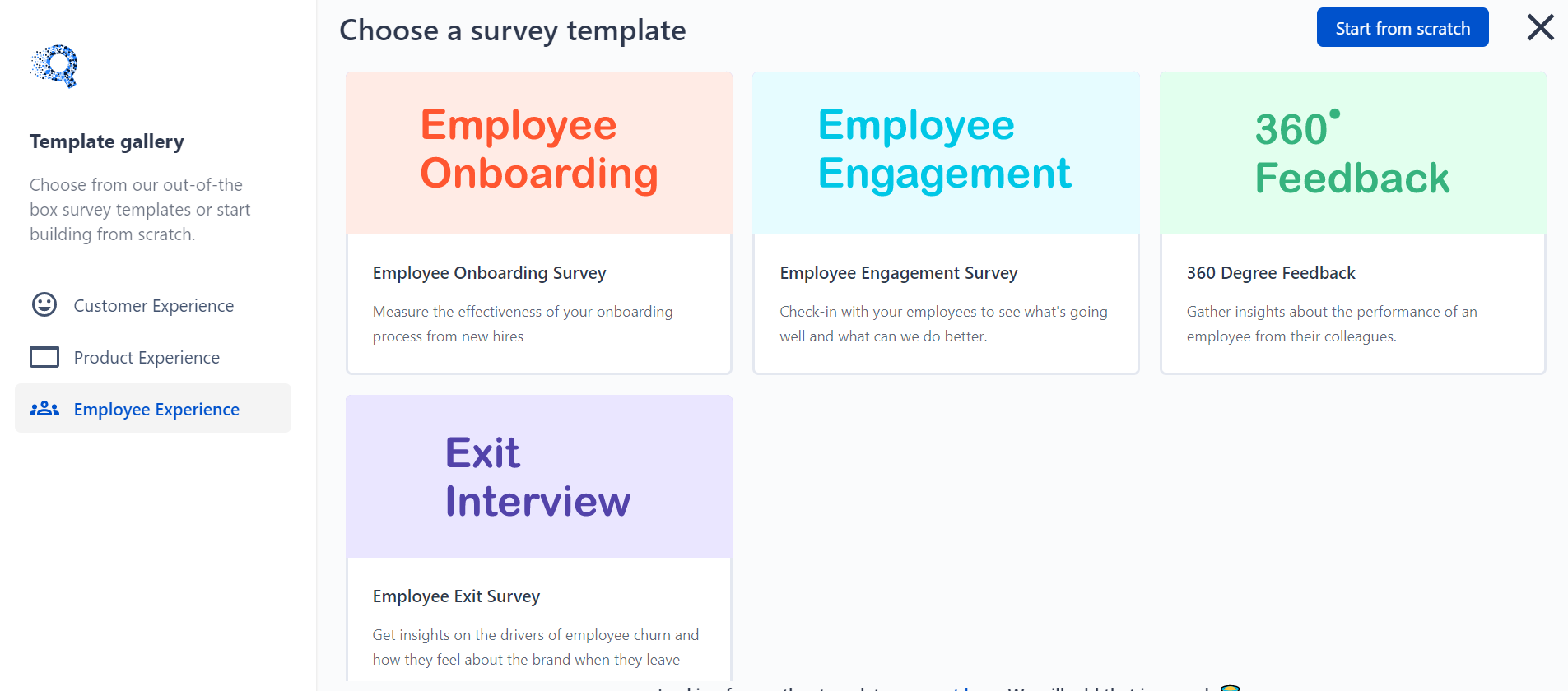
STEP 3: Customize the questions as per your brand and employees, just like shown in the image of the 360 feedback employee satisfaction survey example.

STEP 4: Share the survey across your organization through any channel you prefer.
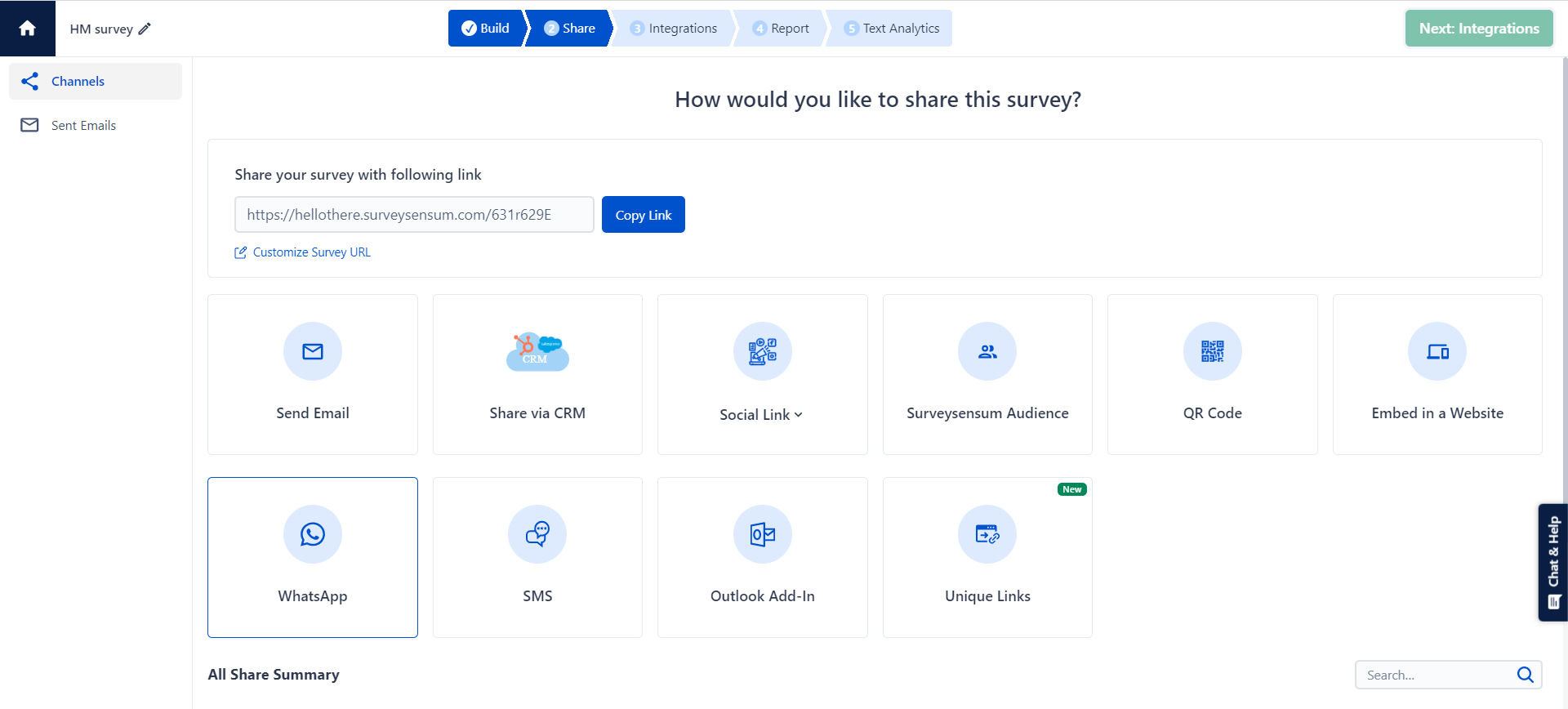
STEP 5: All the feedback gathered is managed, analyzed, and reported in one comprehensive dashboard.
A Few More Words..
360-degree feedback if used efficiently, can increase communication and foster employee development. It can also increase the productivity and efficiency of the team.
360-degree feedback indeed provides valuable insights that you might never have explored before, as it not only gives you an honest rating but also promotes change in work culture and brings self-awareness.
But all the efforts of creating open communication and boosting employee engagement will remain half-baked if you don’t pair it with a robust employee feedback tool like SurveySensum. This tool will help you create effective and customizable surveys, but that’s not it. You can manage and analyze the data gathered automatically with text and sentiment analysis to get a detailed and consolidated view of your EX.













